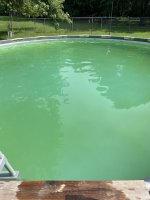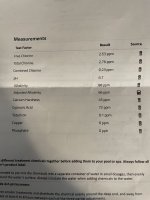Hi, welcome to TFP! We need to do a little pool myth debunking. 1st an above ground pool is no more difficult to take care of than an inground pool. All you need is the proper tools and equipment. 2nd Powder shock is not the best product to clear a pool. I'm going to be giving you a lot of information in this post so please feel free to ask any questions you may have. Since you have a family connection to the pool care industry, the information we give you is going to sound a bit odd. At TFP we don't follow conventional pool care standards and I will outline why in the next paragraph. We advocate testing with your own test kit and not trusting results from the pool store. Pool stores offer "free" testing to increase sales. It is a sales tool. Also many pool stores use computer based testing to be more "accurate". The problem is that computer based testing needs frequent recalibration to give accurate results, and you as the customer have no way of knowing when they last calibrated their test equipment. We also do not recommend test strips, except strips for borates or salt testing. The regular all in one test strips are seldom accurate and do not give precise enough test results to balance the pool properly.
The problem with conventional pool care recommendations is that they treat each chemical value as a separate entity that has no relationship to any other chemical value. For example, conventional recommendations only look at chemical values in their individual ranges, such as FC (chlorine) must be between 1-3ppm, without taking into account how other chemical values interact with each other. This is why they will say a CYA of 90 and FC of 2 are "perfect", because they both fall within the acceptable range for each value. However, CYA and Chlorine must be maintained in a proper ratio to each other. If you look at the FC/CYA Chart you will see that if CYA is 90 in a manually chlorinated pool, FC of 2 is far too low and algae will form under those conditions.
TA and pH are another example. Conventional standards want a TA of 90-120 and pH of 7.5 TA is generally only a concern when pH is difficult to balance. If you have a TA of 70 and a pH of 7.5 there is no need to adjust the TA just to meet an arbitrary value. If you do raise the TA to 90, then your pH is also going to rise. If you lower the pH the TA will also drop. pH can be 7.0 to 7.8 in most pools without causing further issues. There is no need to chase a perfect TA and a perfect pH if your pH is in the acceptable range and fairly stable. TA by itself means nothing.
pH and calcium also have a relationship to watch. Conventional recommendation for calcium is 250-450ppm and in most pools this is not a problem. However if you live in an area with very hard water it may be next to impossible to keep the calcium below 450. In that case it is important to keep your pH low, around 7.0, to prevent calcium scale formation in the pool.
Strictly following conventional recommendations can lead you to a pool full of problems if you don't know how the relationships between chemicals work. Knowing these relationships also guides what types of products to use in the pool. If CYA is high enough you don't want to use dichlor granules or trichlor tablets in your pool to provide chlorine. Both of these products contain CYA and will cause CYA to rise over time. The only way to get rid of excess CYA is to drain water out of the pool. It does not evaporate out with the water. Calcium hypochlorite adds calcium to the water along with chlorine. Like CYA, the only way to get rid of excess calcium is to drain water. Liquid chlorine is the only chlorine source that does not add either CYA or calcium to a manually chlorinated pool.
TFP has the real life experiences of thousands of pool owners, plus the opinions of professionals who have read peer reviewed research that supports our pool care method. Our methods work for the majority of private pool owners. I would urge you to get an FAS/DPD based test kit such as the TF 100 or Taylor K2006 so you can take control of your pool. Based on the information you have given us so far I would say that the bags of "shock" you used have raised the CYA level too high and the chlorine is not high enough to be effective against algae. As Marty recommended read up on the
SLAM Process process and order a test kit. You will probably need to drain about 1/2 the volume of your pool and replace it with fresh water to begin the slam process and get the CYA level down. Only use liquid chlorine from now on.





